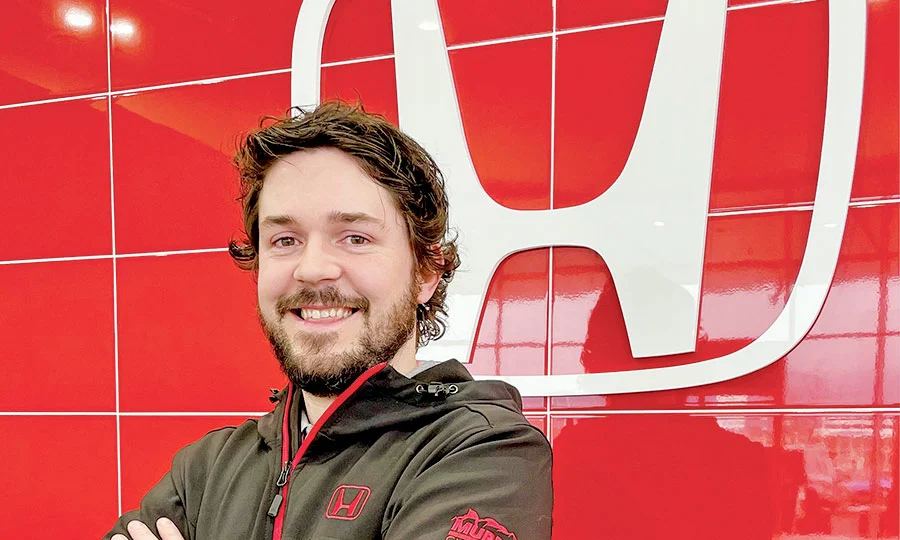We’re beginning with awards in today’s 3D Printing News Briefs, as Hexagon has recognized two winners in its first Sixth Sense cohort of manufacturing startups, and then on to automotive, as we discuss how the supply chain could be helped by 3D printing at the dealership. In materials news, Carbon and adidas have made a sustainability breakthrough with plant-derived materials for 3D printing, and Barilla’s 3D printed pasta is now available to purchase. Finally, a stork is back on its feet again thanks to a 3D printed prosthetic.
Hexagon Crowns Two Winners in Cohort Manufacturing Startups

L-R: Paul Boris, President of runner-up Praemo; Milan Kocic, Head of the Sixth Sense platform, Jan Büchsenschütz and Felix Fink, co-founders of winner RIIICO; Cody Burke and Robert Haleluk, co-founders of winner SmartParts.
This winter, Hexagon’s Manufacturing Intelligence Division launched its new approach to the traditional accelerator, called the Sixth Sense cohort, which was designed as an exchange of value between Hexagon and the participating manufacturing startups. To challenge how multinationals approach innovation, the company connects with participating startups to help nurture creative solutions to humanity’s manufacturing challenges. After an intense eight-week training program and a final presentation to the judges, Hexagon has announced the winners of its first cohort of startups, which will work to help the manufacturing industry operate more efficiently and sustainably, with the help of Hexagon’s customer base.
The runner-up is Praemo, which developed a manufacturing insights application called Razor that ingests data as-is from automation, historians, quality, and maintenance systems to drive continuous improvement, using machine learning, in areas like productivity, cost, and throughput. The first of the two cohort winners is RIIICO, which designed an AI-powered drag and drop virtual factory floor. The solution creates a digital twin of a plant with one 3D scan, which gives teams flexibility and tools to collaborate and improve on factory design. SmartParts, which created an embedded digital barcode for 3D printing, is the second winner. Its novel traceability solution is based on data-rich particles that form the barcodes and can be embedded into materials of 3D printed parts; once scanned, the barcode reveals the part’s material, history, and specifications.
Ease Automotive Supply Chain Issues by 3D Printing at the Dealership
Some people, like Kurtis Wilde, believe that a lot of automotive supply chain hold-ups could be solved if car dealerships had their own 3D printers onsite. Wilde, parts manager at a Murray Honda in British Columbia, owns two small 3D printers at home, and thinks that dealerships could currently use the technology to print small, plastic, non-safety related parts on-demand that have been back-ordered, and get vehicles back on the road quicker; in the future, metal 3D printing could even be added for more intense parts. There are some inherent challenges, of course, such as high 3D printer prices, the risk of counterfeiting, and the fact that all auto parts must go through a tough process called advanced product quality planning, which requires parts suppliers to demonstrate that they understand how parts are designed, and that they have a repeatable process to produce these parts at the highest quality standard. But there are also benefits to 3D printing at the dealership, including high levels of vehicle customization and personalization. But one thing is for certain: the more automakers become familiar with and adopt 3D printing, the quicker the path is being paved for car dealerships to start printing parts as well.
This spring, Wilde said, “We’ve got cars that have been down since Novembers. Just think how helpful it would be if [3D-printed parts at dealerships] were a possibility.”
adidas Using Carbon’s Plant-Derived Resin to 3D Print Midsoles
Carbon and adidas have long partnered to 3D print athletic shoes. Now, the 3D printing leader has developed a bio-based elastomer that can be used to print large volumes, and the athletic company is already using it to create midsoles for its 4DFWD sneakers. This durable new resin, EPU 44, is so named because 40% of its weight is derived from raw plant material. Carbon says the material, which is exclusive to its Digital Light Synthesis platform, is stiffer, more sustainable and resilient, flexible, and is available in white and translucent gray. The company also says EPU 44 enables lighter 3D printed lattices, and prints faster, than its EPU 41, and is commercialized as a General Factory product, requiring industrial dispensing, cleaning, and baking equipment. Serial production is available in China, Taiwan, and Germany.
“Many product designers who rely on foam are performance constrained by the linear compressibility of foam. Companies like adidas, Specialized, and Selle Royal are now breaking through that limitation by developing next-gen products focused on improving energy return via elastomeric lattices,” Carbon wrote.
“As product teams look for new applications of elastomeric lattices, they want to push in new directions, requiring different characteristics that were previously unattainable, all the while maintaining great functional properties, aesthetics, durability, and cost-effectiveness. EPU 44 enables them to achieve these benefits.”
Barilla’s 3D Printed Pasta Now Available for Sale
For the last several years, Italian company Barilla has pretty much owned the market when it comes to 3D printed pasta. Now, this tasty offering is available to purchase via BluRhapsody, a spinoff project born out of its R&D department. Based out of Parma, Italy, BluRhapsody is the first startup of Blu1877, a company that supports and interacts with people working to create the future of food. The main product that BluRhapsody offers is a selection of high-quality durum wheat semolina, processed and kneaded in small batches for the right texture before it’s combined with water and a natural extract with coloring properties.
Each piece weighs 7 grams and measures about 1.1 x 1.8 inches, and the startup offers 15 different custom pasta shapes, including butterflies, shells, hearts, and even words! It costs between $26-$60 to purchase 12 large pieces of 3D printed pasta, which is reasonably affordable for chefs to use in creating tasty, distinct dishes. However, we don’t know if consumers will pay more for this unique meal in a restaurant setting, and more importantly, if the taste of the 3D printed pasta will be preserved.
3D Printed Prosthetic Leg for a Stork
Finally, a female stork named Yuma, who lives in Italy, is walking much better after receiving a 3D printed leg prosthesis. Yuma was adopted by the Parco Natura Volalto in Rome, which helps in the conservation efforts of endangered species and offers environmental education to children. Her right leg was fractured, resulting in the amputation of the lower half, and the other leg was starting to become inflamed as well; a solution was needed if she hoped to have a chance of walking normally again. Her owners, Alessandro Guidi and Gianluca Monti, took the stork to many veterinary specialists in Italy, and finally found the help they needed in Naples with Dr. Emilio Noviello, a veterinarian for exotic animals.
Dr. Noviello, who called the process a “team effort,” took the stork to see Dr. Ciro Marra at the Diaz Veterinary Clinic, where CT scanning was used to get a more complete picture of Yuma’s leg and stump. The scans were processed by Dr. Matteo Zanfabro of PlayVet in Padua, who then designed and 3D printed the prosthetic leg for Yuma. The prosthesis would keep the disease from advancing to the other leg, and allow the stork to lead a more normal life. Yuma adapted quickly to the prosthesis, which took a lot of unnecessary weight off of her healthy leg and caused the inflammatory pathology to regress, and now she seems to be doing just fine. Check out Dr. Noviello’s Instagram to see videos of Yuma up and about with her 3D printed prosthesis!
Subscribe to Our Email Newsletter
Stay up-to-date on all the latest news from the 3D printing industry and receive information and offers from third party vendors.
Print Services
Upload your 3D Models and get them printed quickly and efficiently.
You May Also Like
The Market and Industry Potential of Multi-Material 3D and 4D Printing in Additive Electronics
Additive manufacturing leverages computer-based software to create components for products by depositing either dielectric or conductive materials, layer by layer, into different geometric shapes. Since its birth in the 1980s,...
3DPOD 262: Bio-inspired Design for AM with Dhruv Bhate, Arizona State University
Dhruv Bhate is an associate professor at Arizona State University. There, he looks at structures, materials, and design. Previously, he worked at PADT as well as in the semiconductor and...
3DPOD 261: Tooling and Cooling for AM with Jason Murphy, NXC MFG
Jason Murphy´s NXC MFG (Next Chapter Manufacturing) is not a generalist service; instead, the company specializes in making tooling. Using LPBF and binder jet, the company produces some of the...
3DPOD 260: John Hart on VulcanForms, MIT, Desktop Metal and More
John Hart is a Professor at MIT; he´s also the director of the Laboratory for Manufacturing and Productivity as well as the director of the Center for Advanced Production Technologies....




































